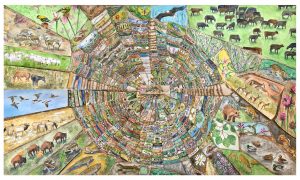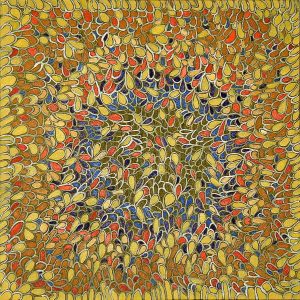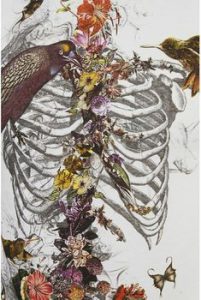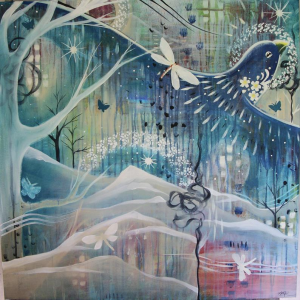 The Columbia City Yoga on-line Moving into Meditation class met this morning. We explored our inter-relationship with world and considered the sentience of the more than human world. We reflected on how our bodies are part of the greater Body of our biosphere. We thought about what it is to live with loving awareness so that we might listen to what Earth is telling us and respond with compassion.
The Columbia City Yoga on-line Moving into Meditation class met this morning. We explored our inter-relationship with world and considered the sentience of the more than human world. We reflected on how our bodies are part of the greater Body of our biosphere. We thought about what it is to live with loving awareness so that we might listen to what Earth is telling us and respond with compassion.
Our guided reflection was inspired by Ruth King’s book, Mindful of Race. Ruth is founder of the Mindful of Race Institute. As a long time meditation teacher Ruth brings mindfulness teaches to help us to cultivate a culture of care. Her book offers very creative and practical guidance for bringing wisdom teachings to life. She encourages readers to explore our interdependence with care and compassion. In this reading she invites us to reflect on Mother Earth’s nervous system as being sensitive to our own beating hearts and minds.
 We also drew from David Abram’s Emergence Magazine essay, Creaturely Migrations on a Breathing Planet. David is a naturalist trained in magic. His eloquence helps to bring awareness to Earth’s aliveness and concern to the more-than human world. David invites us to consider our bodies entangled with the larger Body of our biosphere. He suggests our intelligence is similar to the sentience of forests, mountains, clouds and waters. We are part of it all and what we do truly matters.
We also drew from David Abram’s Emergence Magazine essay, Creaturely Migrations on a Breathing Planet. David is a naturalist trained in magic. His eloquence helps to bring awareness to Earth’s aliveness and concern to the more-than human world. David invites us to consider our bodies entangled with the larger Body of our biosphere. He suggests our intelligence is similar to the sentience of forests, mountains, clouds and waters. We are part of it all and what we do truly matters.
We heard Anne Hillman’s poem, Awakening the Energies of Love. The poem, from her collection The Dancing of Animal Woman, is about nurturing a more inclusive kind of love: a love that empowers, transforms and creates new possibilities. It affirms Ruth’s encouragement for us to relinquish our habits of harm and open ourselves to new ways of being.
Last week we explored the ways we meet life transitions. With mindfulness we can meet them as expressions of the many of causes and conditions of which we are inextricably entangled. With the space of loving awareness we can bring “care and conscious attention” to ourselves and those around us. We can appreciate our rose nature.
This week I thought about what it means to live with loving awareness. I went back to Ruth King’s writings on how we can cultivate a culture of care. She writes:
. . . . To cultivate a culture of care is to be in relationship with humanity with a wise heart. This includes having moral character . . . What I mean by moral character is that we understand and aspire to live by three principles of social harmony: interdependence, compassion and harmlessness.
I resonate with Ruth’s simple and profound way of exploring what it means to be in relationship with a wise heart. I would include humans and more-than-humans in our relationships of caring. Ruth reminds us that mindfulness can be the practice of “remembering that we are part of something larger than our individual selves . . . and what we do has impact. She writes:
 . . . we all coexist in a vast skinless body held together by the gravitational pull of Mother Earth’s love, shaped in a unique cell suit that we call “self.” In this proprioceptive relationship with all existence, each “cell self” represents the whole of existence. . . . In this skinless body is a vast nervous system sensitive to the movement of mind and the beating of hearts. As we become more conscious of our conditioning . . . we enhance the whole of humanity [with] our lived example.
. . . we all coexist in a vast skinless body held together by the gravitational pull of Mother Earth’s love, shaped in a unique cell suit that we call “self.” In this proprioceptive relationship with all existence, each “cell self” represents the whole of existence. . . . In this skinless body is a vast nervous system sensitive to the movement of mind and the beating of hearts. As we become more conscious of our conditioning . . . we enhance the whole of humanity [with] our lived example.
Mother Earth has a nervous system. She is alive with a system that gives and receives messages. She has sensations, perceives, thinks and feels. She learns and remembers. She moves and sleeps. She ages, becomes stressed and injured. She heals. I think about the impact my own mind and beating heart have had on Earth’s mind and heart I think about how my ancestors’ bodies have impacted her body.
In his Emergence Magazine essay, Creaturely Migrations, naturalist David Abrams writes about our interdependence with the more than human world. He asks us to acknowledge our inter-relatedness with “creaturely empathy.”
 . . . [O]ur animal body still takes its final directives from the larger biosphere—it still needs to breathe, and to drink fresh water. It remains susceptible to illness, to creaturely empathy, to the upwelling of earthly wonder. As planetary temperatures rise ever higher, as local weather patterns go haywire, the invisible atmosphere that conjoins our sentience with the sentience of cedar trees, sandhill cranes, and salmon becomes more insistently evident . . . muscling its way back into consciousness. . . . [W]e find ourselves immersed . . . in the terrifying beauty of a world that exceeds all our knowing.
. . . [O]ur animal body still takes its final directives from the larger biosphere—it still needs to breathe, and to drink fresh water. It remains susceptible to illness, to creaturely empathy, to the upwelling of earthly wonder. As planetary temperatures rise ever higher, as local weather patterns go haywire, the invisible atmosphere that conjoins our sentience with the sentience of cedar trees, sandhill cranes, and salmon becomes more insistently evident . . . muscling its way back into consciousness. . . . [W]e find ourselves immersed . . . in the terrifying beauty of a world that exceeds all our knowing.
Is this biosphere our actual Body, the broad metabolism in which our smaller, more transient bodies are entangled? Is not our intelligence the interlaced activity of these leafing forests, these mountains conjuring clouds out of the fathomless blue . . .?
Let’s sit together as these many words and ideas, images and associations move through our body/minds. You might take a few deep slow breaths feeling the largest sensations of breathing in deeply. Feel how they may diminish with the smallest sensations of breathing out completely. As you are ready let the breath, breathe itself. Each successive moment relaxing what ever you can.
 Notice what you are aware of. Is it possible to explore this awareness in the body? What is the felt sense of this awareness? How is it to be present with feeling? Notice any impulse to jump out of feeling and into thinking. Can you let there be spacious awareness around this impulse? Notice your response. How would it be to meet your response in a non-harming way? Moment by moment, bring your attention to this experience of being. Can you breathe and notice the transitory nature of being? Nothing is permanent.
Notice what you are aware of. Is it possible to explore this awareness in the body? What is the felt sense of this awareness? How is it to be present with feeling? Notice any impulse to jump out of feeling and into thinking. Can you let there be spacious awareness around this impulse? Notice your response. How would it be to meet your response in a non-harming way? Moment by moment, bring your attention to this experience of being. Can you breathe and notice the transitory nature of being? Nothing is permanent.
Bring your awareness to those areas where your body feels the support of Earth’s body. Breathe and sense how these two living bodies relate to one another. Is it possible to relax and explore this experience of connection, this relationship with caring? Breathe and sense how it feels to breathe together. Let yourself breathe in and out of the space that goes beyond the walls of the room you are sitting in. It’s a spaciousness that’s limitless. You can listen to this space beyond boundaries.
 What might you discover about yourself if you were to spend time receiving the in-breath as a gift, offering the out-breath gift? What would it be like not having to take anything?
What might you discover about yourself if you were to spend time receiving the in-breath as a gift, offering the out-breath gift? What would it be like not having to take anything?
We can explore breathing in this way, in caring relationship, taking nothing, doing no harm. We are moving out of habits of harm as we enter and abide in caring presence. We are cultivating a condition in which awareness and healing arise. Awareness and healing arise without taking, without harming.
In this space of loving awareness we might consider all beings and all more-than-human beings. We might affirm our inter-being with our consideration and respect, by the compassionate way we move through the world. This practice invites us to open ourselves so that our assumptions and beliefs of who we are can adjust and grow. It’s a practice of openness and receptivity in which we can receive what Mother Earth is telling us today. We can receive ancestral wisdom from all that has come before us. All of this is given to us. How will we receive it? As difficult as it may be, we can remember that we are not alone.
Let us look with uncertainty as poet Anne Hillman suggests:
 We look with uncertainty
We look with uncertainty
beyond the old choices for
clear-cut answers
to a softer, more permeable aliveness
which is every moment
at the brink of death;
for something new is being born in us
if we but let it.
We stand at a new doorway,
awaiting that which comes…
daring to be human creatures,
vulnerable to the beauty of existence.
Learning to love.

